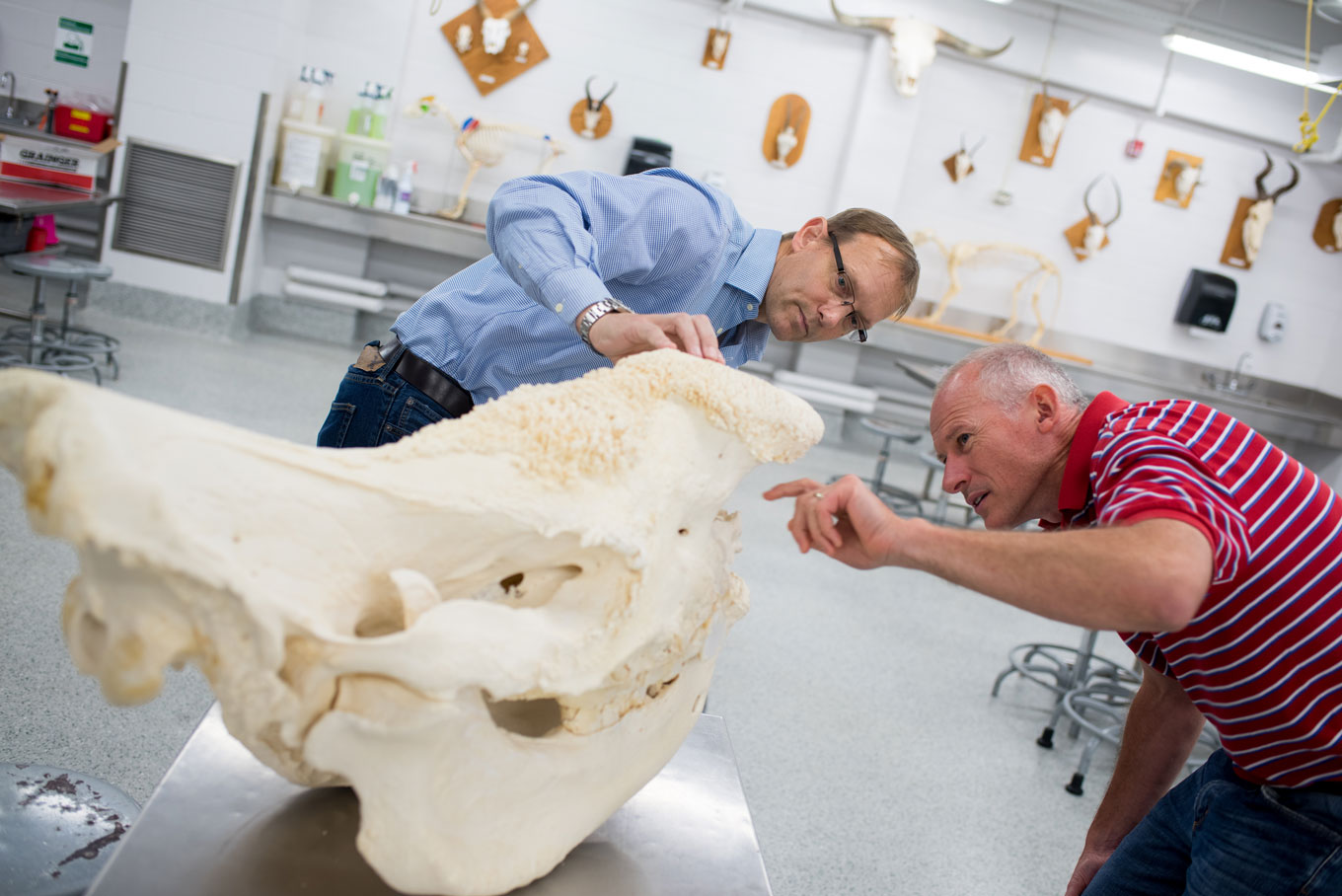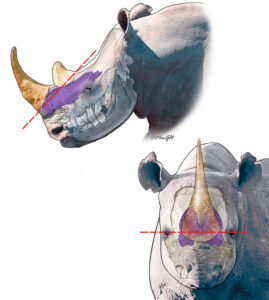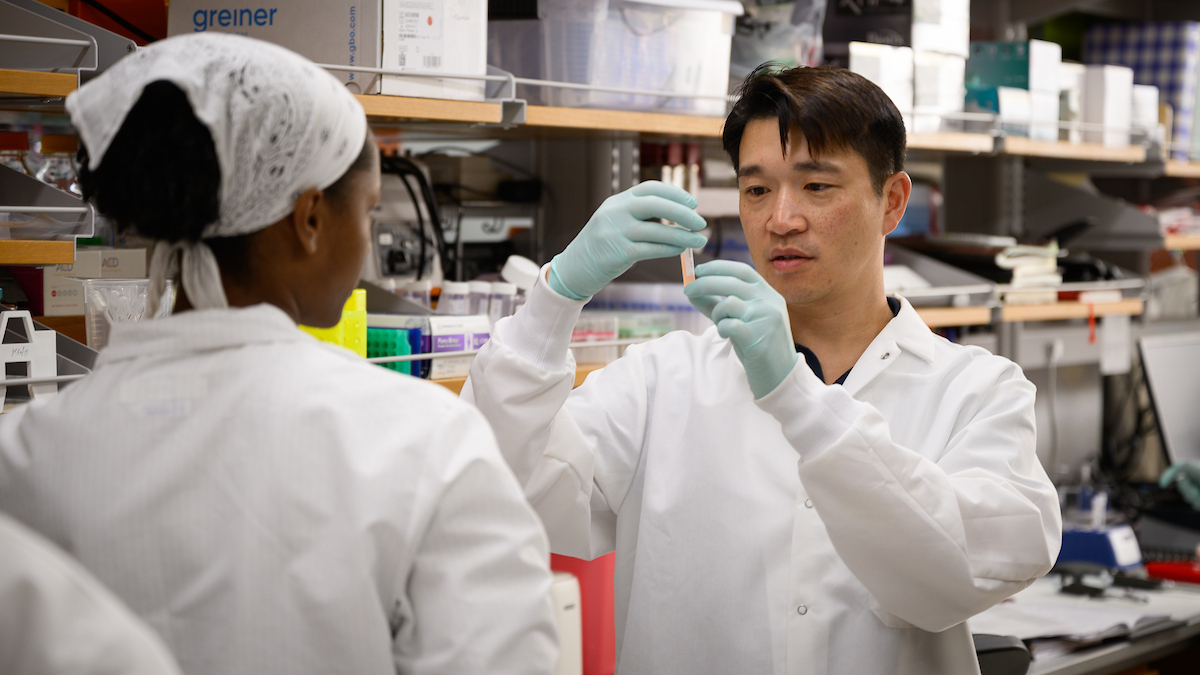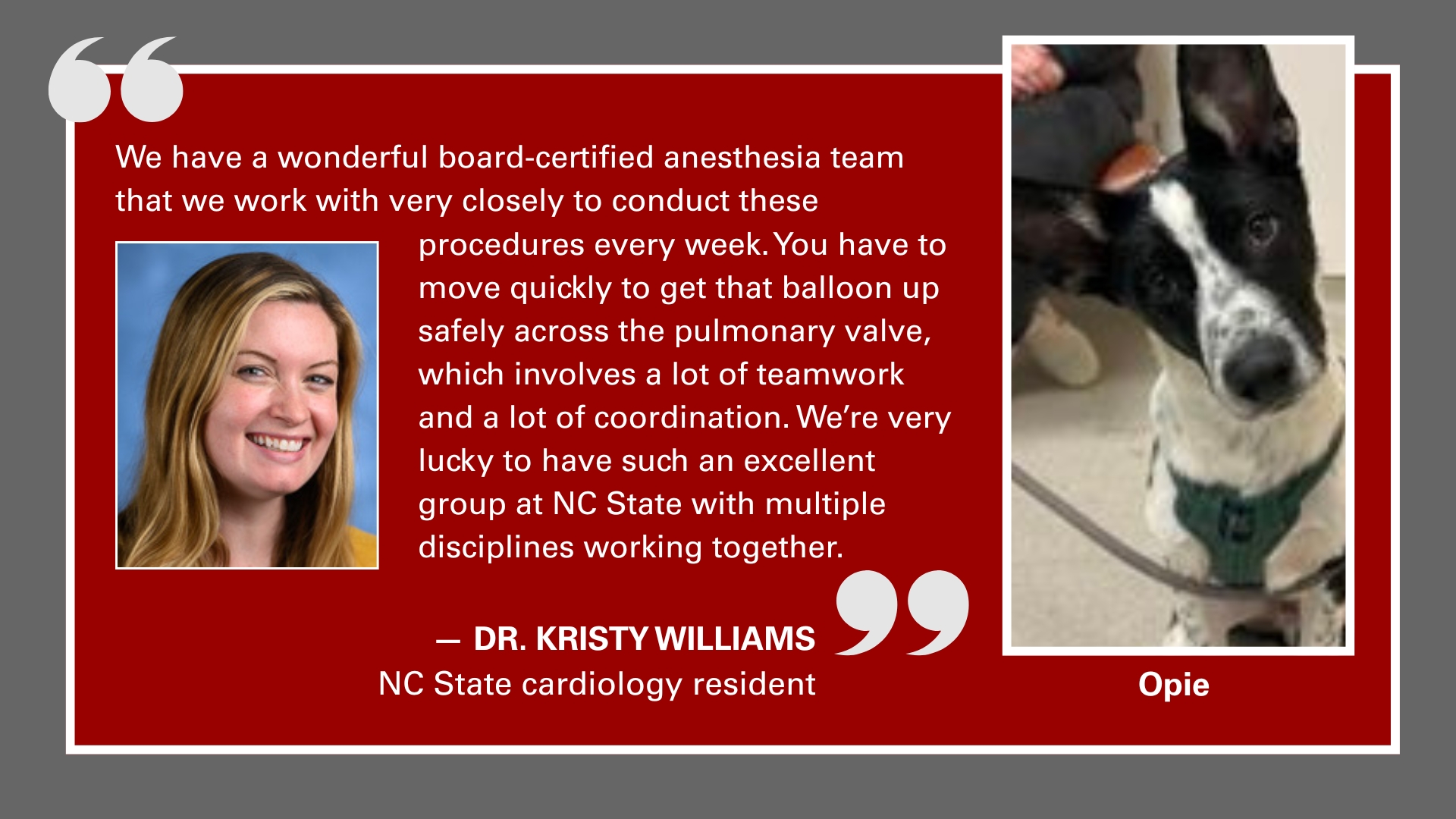Life-Changing Impact

A few days before colleagues and close friends Anthony Blikslager and Mathew Gerard began a research project that could save hundreds of threatened rhinoceroses, Gerard saw one in the wild for the first time.
The next day, he saw one that had been slaughtered.
In June, he was in the game reserves surrounding Kruger National Park in South Africa. To Gerard, an anatomy professor at the North Carolina State University College of Veterinary Medicine (CVM), it was constantly rewarding, just being here. He and his wife Dr. Wendy Simpson, also a veterinarian, had never had a safari experience.
They saw plenty of white rhinos, a few black rhinos. Gerard took in the sight of a solitary rhino drinking from a lake. It was spiritual and inspiring and like nothing he had ever seen.
“It’s like viewing a photograph of the Grand Canyon. It doesn’t do it justice until you’re there seeing it with your own eyes,” says Gerard.
But in this place of strikingly uncommon beauty, there’s sheer violence.
[pullquote color=”green”]“It’s incomprehensible to me that someone, anyone, could go in and destroy these animals in the way that it is happening…”[/pullquote]
Gerard saw the dead rhino on one of their safari drives. It was laying on its side under a tree, its eyes open, the front portion of its face hacked off by poachers. Blood streamed down its leg from a tiny bullet hole in its side. Its ears and the back of its head were also missing, presumably to slow the ability of anti-poaching squads to identify it through markings, Gerard says. The wounds were fresh and raw.
This rhino could have been any Gerard had seen earlier on safari — one of a pair traveling together looking for food, the one coating itself in mud to keep cool. It could have been the one he had seen quietly drinking water.
“It’s incomprehensible to me that someone, anyone, could go in and destroy these animals in the way that it is happening,” Gerard says. “I’ll never understand that side of it.”
In a few days Gerard and Blikslager would be meeting in Onderstepoort, near Pretoria, to study these majestic animals quickly vanishing from the Earth because someone desires their horns, amongst other things a highly desired ingredient in traditional medicine practiced in parts of Asia.
There was something specific that needed to be done to help these animals. It was something they could do.
The Mission
Gerard and Blikslager had never worked with rhinos before — or even really studied them — but they ended up uniquely suited to a task almost two years in the making: mapping the paranasal sinus anatomy of the white rhinoceros, believed to be the first such project of its kind.
They planned the trip to South Africa to visit Dr. Johan Marais, an equine and wildlife surgeon at the University of Pretoria, who has now dedicated the majority of his time to helping poached rhinos as part of the nonprofit Saving the Survivors, which he co-founded in 2012. Blikslager first visited the university in 2014 to continue a study on equine colic that had started at NC State with an equine medicine resident from South Africa. There, he spent some time talking horses with Marais. Soon, the conversation turned to rhinos.
[pullquote color=”green”]“Our work has started on this pathway of increasing our knowledge of the most frequently affected anatomy during rhino horn poaching…” [/pullquote]
“He said, ‘I’m really interested in wildlife, particularly rhinos, and you probably don’t have any interest in that,’” says Blikslager, a professor of equine surgery and gastroenterology at the CVM. “So I said, ‘Why don’t you show me?’”
What Marais showed Blikslager were poached rhinos and the wounds he was left to deal with on the ones he could rescue. But Marais was unsure of exactly what he was looking at.
“Currently, we are losing more than 1,000 rhinos a year to illegal rhino horn poaching, and nobody knows how to treat these rhinos or knows the anatomy,” says Marais. Knowledge of the anatomy and development of surgical procedures could save these endangered and vulnerable species.
Blikslager jumped at the chance to help. He connected Marais with Gerard, an equine surgeon now focused on teaching anatomy. They communicated with Marais over Skype for 18 months before the June visit.
They got to work right away in South Africa, a trip sponsored by NC State University. Over four days, usually about eight hours a day, they faced the massive head of a cadaver rhino that had been frozen and thawed by Marais in anticipation of their visit. They reviewed what Marais had learned from CT scan studies and his initial attempts at mapping the paranasal sinus anatomy. Then they spent hours dissecting, documenting and discussing the anatomy.

It seems quite simple, especially compared to the advances in wound treatment for rhinos lucky enough to survive a traumatic poaching, but a thorough understanding of the paranasal sinus anatomy helps these animals immensely, from knowing simply what happens to the sinus spaces once a rhino’s horns are brutally removed to how they connect together and drain into the nasal cavity.
When a rhino’s horns are hacked away — either by machete or axe or hand saw — and the animal survives, the paranasal sinuses are always exposed. Until Blikslager and Gerard’s research, no one, including those working to save rhinos, had any idea what cavities they were looking at and how they were interrelated.
What was needed was an accurate description of the trauma the sinuses sustain during horn removal, where accumulated fluid (ex: blood, or pus in the case of a sinus infection) drains to the nasal cavity and where, perhaps, surgeons could create new holes to help facilitate sinus drainage of blood or other fluid during long-term treatment.
“The numbers in the wild are diminishing so quickly that there has to be efforts to keep alive any and all rhinos left,” says Gerard. “Our work has started on this pathway of increasing our knowledge of the most frequently affected anatomy during rhino horn poaching.”
At the school’s Onderstepoort Veterinary Academic Hospital, the two dissected the paranasal sinuses of the white rhino cadaver head, using their knowledge of horse anatomy as somewhat of a guide (the animals share similar anatomical structures, but they found paranasal sinus spaces in the rhino head that do not exist in horses). By the end of the four days, they had a clear understanding of the white rhino’s uppermost paranasal sinus, the region that gets routinely opened when the horns are removed. With the help of colleagues at Onderstepoort, they meticulously used a bandsaw to section the head and see the length and breadth of the sinuses, and also used a blue dye to determine pathways between the spaces, by filling one space with the dye and seeing if it flowed out somewhere else.
“What really matters when you traumatize the sinuses is that they bleed,” says Blikslager. “And head wounds bleed, but a sinus wound really bleeds. So then that’s got to drain somewhere.”
“We thought it would be really important to find out where the sinus space opens. And we were trying to ask questions like, ‘Do you ever see a problem with the sinus filling and not being able to drain?’”
A key veterinary medical principle is being able to clean out a wound and enabling it to drain. By mapping the paranasal sinuses in the rhino, Gerard and Blikslager identified the cavities that are exposed when the horns are removed and were able to pass an endoscope through the nasal passage and into the newly discovered sinuses to confirm where they drained.
[pullquote color=”green”]”Dr. Marais didn’t know there was this hole coming out of that sinus space. Just didn’t know that. None of us knew that,” says Gerard[/pullquote]
As a result, they also determined that those treating rhinos could potentially create additional drainage holes if needed to manage a secondarily infected sinus following horn poaching. If an infected sinus doesn’t have an adequate outflow into the nasal cavity, then it needs help. The pair now know, Gerard says, that treatment can include opening up areas of the sinus wall to reestablish drainage for an infected sinus into the nasal cavity and where that can be done.
“Literally, before we started looking at this cadaver together, Dr. Marais didn’t know there was this hole coming out of that sinus space. Just didn’t know that. None of us knew that,” says Gerard. “You could almost see a sense of relief in his face when we showed him the opening because he suddenly felt like, OK, at least I now know it’s this big space that gets filled up with blood but has a way to drain.”
Marais agrees that Blikslager and Gerard’s research is already having an effect on how his team treats injured rhinos.
“By working on these terrible facial injuries we realized that they are extremely sensitive on the face although they are under immobilization,” says Marais. “Just by touching the area where the horn was hacked off, the rhino would react violently. So by using the CT software and working out where the infraorbital nerve exists, we got landmarks on the live animal. We then started blocking this nerve before working on the animals. It turned out to be very effective.”
“My only complaint,” adds Marais, “was that Mat and Anthony were not here long enough.”
A Perfect Team

Blikslager and Gerard’s lives have intertwined for more than two decades at NC State. Gerard arrived as a resident in equine surgery in 1994, the year Blikslager completed his surgery residency, and they have been close friends and colleagues ever since.
They’ve worked together extensively in the equine hospital, collaborating on several research projects. Gerard says that from the day he started at the CVM, Blikslager has been a valued mentor. They respect each other and they also like each other.
“We have been through some tough times together, like the time we were being filmed on a complex equine surgery by Animal Planet,” says Blikslager. “I had told the interviewer that the only thing I did not want to do was puncture a large vessel, so we punctured a large vessel. The show was called ‘Animal Operation.’ I have the video tape.”
“Ahh yes, the ‘Animal Operation’ surgery!” Gerard adds.
Their career paths have diverged after Gerard focused on teaching anatomy, but their professional relationship remains the same; they consider the rhino research project a fantastic way to work together again.
“This recent trip was two old mates getting a bit of time away,” says Gerard.
It was also so much more, of course. They knew that fact going in and it was abundantly clear while they were there. According to Saving the Survivors, 1,338 rhinos were poached in 2015. Just six years ago, that number was 125. Since its founding, Saving the Survivors says it has saved more than 200 poached rhinos.
[pullquote color=”green”]“There are some sources that suggest that by 2024, so we’re talking eight years away, that there won’t be any more rhino left in the wild…” [/pullquote]
“There are some sources that suggest that by 2024, so we’re talking eight years away, that there won’t be any more rhino left in the wild,” says Gerard. “They will all be captive rhino at the current rate of poaching.”
Both Blikslager and Gerard say they now feel they have a responsibility to be a part of stemming that tide. They both feel honored to contribute to the survival of an animal that desperately needs help.
“To some degree it feels a little bit like you’re on the edge of such a massive problem. It’s like being on the edge of a giant chasm,” says Blikslager. “I think we can all appreciate these animals and recognize the importance of these animals and recognize the necessity of having them around.”
“I think everybody wants to know that some place in the world there is a thing that’s called the wild, with wild animals in it. We just want to know that. You could be living in New York City, but you like to know that there’s some place.”
A Rhino Called Hope
Toward the end of their trip, Blikslager and Gerard left the confines of the lab and went into the wild.
This is where Saving the Survivors does their surgical conservation work, close to the very areas where some of the rhinos they are treating were initially poached. This is where Blikslager and Gerard met Hope.

Hope, a white rhino that has become a symbol of sorts of Saving the Survivors’ mission, has undergone several procedures to repair the damage to the top of her head, cleaved off whole by unidentified poachers. Hope, living in an enclosure, sports a swath of white bandages and elastic bands, stapled into place at the top of her head because most of the bone required for drilling and holding a shield attachment had been removed.
It will be years before Hope fully recovers, if she recovers at all. Hope’s wound may close some more, says Blikslager, but it will likely remain open to a degree.
It’s their work on mapping the anatomy of the rhino paranasal sinuses that could help determine further treatment for Hope. Or treatment for other Saving the Survivors rhinos like Lions Den and Dingle Dell, two rhinos darted by poachers on Kapama Game Reserve, their horns neatly cut off with a chainsaw leaving their sinus spaces open. Or treatment for Higgins, who lost 80 percent of his eyesight after a poaching attack.
Or treatment for the estimated hundreds of rhinos already poached this year.
“We’re in this experience with this massive animal, touching her skin, looking at the skin on the rest of her body,” says Gerard about seeing Hope. “The skin can be almost two inches thick in some places. When you stop and look at yourself and think about what you’re doing. No, this isn’t a horse with a traumatized face. This is literally this massive wild animal in front of you. That was surreal in many respects.”
This was Gerard’s first trip to South Africa; it was Blikslager’s second. Blikslager says it gave him a different perspective on veterinary medicine. And he said South Africa, where the division between the poor and wealthy is immediately and crushingly clear, gave him a different perspective on life.
“I felt really lucky, but at the same time very responsible to really make the experience count,” says Blikslager.
During the course of this interview, the two went from saying they generally would like to go back to South Africa, possibly with CVM students, to saying it could likely happen in two years to definitely telling each other that they wanted to go back in a year — that they needed to go back.
This is a species that could potentially no longer be walking wild on the planet in less than 10 years. They won’t forget that.
“It’s a privilege to be a part of helping them. That’s the way I look at it,” says Gerard. “If Marais called up and said, ‘Mat, I need you on a plane tomorrow and we want you out in South Africa for two years to help us work on these animals,’ I’d probably jump on the plane without thinking too hard.
“As much as I love what I’m doing here at NC State right now, that’s the way I feel about this. This is sort of a once-in-a-lifetime experience, and I wouldn’t hesitate to be more involved.”
[highlight color=”gray”]
[fa_icon name=”fa-search” size=”1x”] Rhinos at a Glance
- There are five species of rhinoceros: the black, the white, the Indian or greater one-horned rhino, the Javan and the Sumatran. The black, Javan and Sumatran rhinoceros are all critically endangered.
- At the beginning of the 20th century, there were 500,000 rhinos in Africa and Asia. Today there are just 29,000 in the wild. There are an estimated 19,700 to 21,100 white rhinos, 5,100 to 5,500 black rhinos, more than 3,500 greater one-horned rhinos, fewer than 100 Sumatran rhinos and about 60 Javan rhinos.
- White rhinos are the second largest land mammal, and can weigh over 7,700 pounds. Elephants, the largest land mammal, can grow to be 15,000 pounds. Rhinos can grow to over 6 feet tall and more than 11 feet long.
- Rhino horns are made from keratin, the same protein in fingernails and hair. The longest known horn on a black rhino was 4 feet, 9 inches long.
- The closest living rhino relatives are tapirs, horses and zebras.
- South Africa has by far the largest population of rhinos in the world.
- White and black rhinos are actually gray. White rhinos get their name from the Afrikaans word “weit,” meaning “wide,” which was misinterpreted by early English settlers as “white.” Black rhinos likely got their name from the dark wet mud they wallow in.
- Poaching has escalated in recent years, driven by use in traditional Asian medicine. Habitat loss and political conflict have also contributed to declining population numbers.
- By the end of 2015, the number of African rhinos killed by poachers had increased for the sixth year in a row, with at least 1,338 rhinos slaughtered. Last year, an estimated 1,175 rhinos were poached in South Africa.
Source: Save the Rhino, savetherhino.org [/highlight]
~Jordan Bartel/NC State Veterinary Medicine


